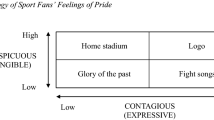Abstract
Sports sponsorship is big business, and a great deal of research provides evidence as to sponsorship’s efficacy in achieving a large range of communication goals, particularly for brands that are perceived as fitting well with the sport by the most involved fans. A developing body of literature, however, suggests that fan passion for a favorite team or athlete might work against the sponsors of hated rivals. The current research contributes to the rivalry effects topic by examining the impact of sponsor-sport fit, business rivalry, and league sponsoring on “home” team fan attitudes towards the sponsors of their team’s main rival. The study finds that negative rivalry effects are particularly severe when the rival team sponsor has high-perceived fit with the sport and is a direct business rival to a “home” team sponsor, but that league sponsorships largely mitigate these rivalry effects.


Similar content being viewed by others
Notes
To confirm the pre-test results showing no significant attitudinal differences between the test brands, data was also collected with press releases that reversed the sponsoring brands (i.e., Gatorade and SAP as rival sponsors), and no significant differences were found in the results. Thus, for reasons of parsimony, only the Powerade and Oracle as rival sponsor results are reported, but details on the reversed brand data results are available upon request.
References
Bee, C., Dalakas, V. (2015). Rivalries and sponsor affiliation: examining the effects of social identity and argument strength on responses to sponsor-related advertising messages. Journal of Marketing Communications, 21, 408–424.
Bergkvist, L. (2012). The flipside of the sponsorship coin, do you still buy the beer when the brewer underwrites a rival team. Journal of Advertising Research, 51, 65–73.
Biscaia, R., Correia, A., Rosado, A. F., Ross, S. D., & Maroco, J. (2013). Sport sponsorship: the relationship between team loyalty, sponsorship awareness, attitude toward the sponsor, and purchase intention. Journal of Sport Management, 27, 288–302.
Dalakas, V., & Levin, A. M. (2005). The balance theory domino: how sponsorships may elicit negative consumer attitudes. Advances in Consumer Research, 32, 91–97.
Herrmann, J. L., Kacha, M., & Derbaix, C. (2015). “I support your team, support me in turn!”: the driving role of consumers’ affiliation with the sponsored entity in explaining behavior effects of sport sponsorship leveraging activities. Journal of Business Research, 69, 604–612.
Hickman, T. M., & Lawrence, K. E. (2010). The halo effect of goodwill sponsorship versus the pitchfork effect of supporting the enemy. Journal of Sponsorship, 3, 265–276.
Jaccard, J., & Turrisi, R. (2003). Interaction effects in multiple regression (2nd ed.). London: Sage.
Jackson, J (2012) Sir Alex Ferguson: Manchester City are United’s rivals, not Liverpool. www.guardian.co.uk, April 26, http://www.theguardian.com/football/2012/apr/26/alex-ferguson-manchester-city-liverpool. Accessed May 10, 2015.
Johar, G. V., Pham, M. T., & Wakefield, K. L. (2006). How event sponsors are really identified: a (baseball) field analysis. Journal of Advertising Research, 46, 183–198.
Loechner, J (2009) Gender and age consumption differs in evolving media usage patterns. Research Brief from the Center for Media Research. http://www.mediapost.com/publications/article/115632/#axzz2iuptWWol. Accessed May 10, 2015.
Olson, E. L. (2010). Does sponsorship work in the same way in different sponsorship contexts? European Journal of Marketing, 44, 180–199.
Olson, E. L., & Thjomoe, H. M. (2009). Sponsorship effect metric: assessing the financial value of sponsorship by comparisons to television advertising. Journal of the Academy of Marketing Science, 37, 504–515.
Olson, E. L., & Thjomoe, H. M. (2011a). Explanations for sponsor identification accuracy. Journal of Sponsorship, 4, 366–376.
Olson, E. L., & Thjomoe, H. M. (2011b). Explaining and articulating the fit construct in sponsorships. Journal of Advertising, 40, 57–70.
Ricadela, A (2012) Oracle and SAP rivalry. http://www.bloomberg.com. http://go.bloomberg.com/tech-blog/2012-03-20-old-rivalries-die-hard-oracles-ellison-takes-fresh-shot-at-sap/. Accessed May 10, 2015.
Statista (2015) Market share of sports/energy drinks worldwide as of 2015. Statista the Statistics Portal. http://www.statista.com/statistics/387428/market-share-of-leading-sports-energy-drinks-companies-worldwide/ Accessed September 16, 2015.
Thompson, S. A., & Sinha, R. K. (2008). Brand communities and new product adoption: the influence and limits of oppositional loyalty. Journal of Marketing, 72, 65–80.
Wann, D. L., & Branscombe, N. R. (1993). Sports fans: measuring degree of identification with their team. International Journal of Sport Psychology, 24, 1–17.
Zillman, D., Bryant, J., & Sapolsky, B. (1989). Enjoyment of watching sport contests. In J. H. Goldstein (Ed.), Sports, games, and play: social and psychological viewpoints (2nd ed., pp. 241–287). Hillsadale: Lawrence Erlbaum Associates.
Author information
Authors and Affiliations
Corresponding author
Rights and permissions
About this article
Cite this article
Olson, E.L. Are rival team fans a curse for home team sponsors? The moderating effects of fit, oppositional loyalty, and league sponsoring. Mark Lett 29, 115–122 (2018). https://doi.org/10.1007/s11002-017-9441-6
Published:
Issue Date:
DOI: https://doi.org/10.1007/s11002-017-9441-6




